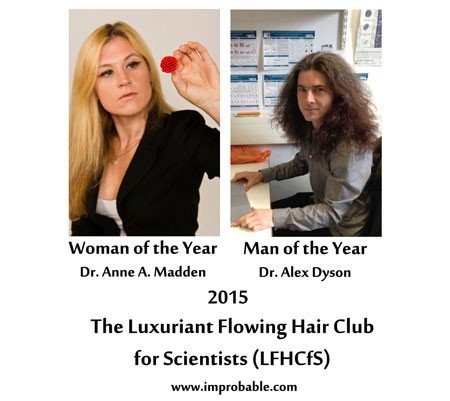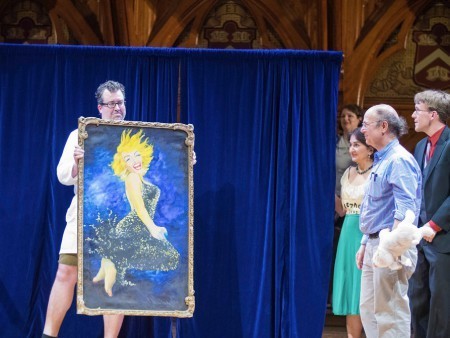Marc Abrahams's Blog, page 352
January 14, 2015
Samuel Flaxman joins two Luxuriant Flowing Hair Clubs for Scientists (LFHCfS)
Samuel M. Flaxman has joined both the Luxuriant Flowing Hair Club for Scientists (LFHCfS) and the Luxuriant Facial Hair Club for Scientists (LFHCfS). He says:
Dr. Flaxman studies speciation theory, with particular attention to the genomic patterns left by processes at work during the formation of two species from one. He is currently building evolutionary population simulations in order to develop quantitative genomic predictions from null and alternative hypotheses. He holds the title of “Best Mullet, 2013,” awarded for his entry as “The Wolverine” in the 2013 Mountain Sun Mullet and Chops Contest (2/28/13). His recent publications include “Theoretical models of the influence of genomic architecture on the dynamics of speciation” and “Genetic hitchhiking and the dynamic buildup of genomic divergence during speciation with gene flow“.
Samuel M. Flaxman, Ph.D, LFHCfS [Click on the image. below, to see an enlarged version.]
Assistant Professor of Ecology and Evolutionary Biology
University of Colorado Boulder
Boulder, Colorado, USA
How to write a technical paper (c.1956)
To complement Improbable’s archives on the subject of “How to write *“
[1] ‘How To Write A Scientific Paper’
[2] ‘How to Write Consistently Boring Scientific Literature’
[3] ‘How to Write a Scientific Paper’ (again)
[4] ‘How to write a crank letter‘
[5] ‘How to write a love letter‘
Can we also now recommend ‘How to write a technical paper‘ by J.F.R Williams, F.M. of Socy., F.P of B.S./T.P. In: Students’ Quarterly Journal, Volume 26, Issue 103, March 1956, page 169. [click pdf logo for full paper]
 First you need a NAME: “There is no greater deterrent to a sub-committee than a mere ‘Harry Brown PhD.’ “ The author suggests instead “Theodosius X.V. Qualfe”, noting that “The paper itself is not important if you take care to comply with the above, except that in no circumstances must it be easy to read.” He goes on to explain that “If you are not adept enough to make your paper unintelligible by fair means, you can distract your readers’ attention by the insertion of multifarious footnotes, particularly if you take the trouble to find some really juicy ones.” Such as “Ruska, E, and Muller, H. O.: Ober Fortschritte Bei Der Abbildung Electronen–Bestralhter Obeflachen– Zeitschrift fur Physik, 1940, 116, p.36”
First you need a NAME: “There is no greater deterrent to a sub-committee than a mere ‘Harry Brown PhD.’ “ The author suggests instead “Theodosius X.V. Qualfe”, noting that “The paper itself is not important if you take care to comply with the above, except that in no circumstances must it be easy to read.” He goes on to explain that “If you are not adept enough to make your paper unintelligible by fair means, you can distract your readers’ attention by the insertion of multifarious footnotes, particularly if you take the trouble to find some really juicy ones.” Such as “Ruska, E, and Muller, H. O.: Ober Fortschritte Bei Der Abbildung Electronen–Bestralhter Obeflachen– Zeitschrift fur Physik, 1940, 116, p.36”
Note: Improbable believes that the citation above contains errors, the correct version should be : Von E. Ruska, und H. O. Müller, Über Fortschritte bei der Abbildung elektronenbestrahlter Oberflächen, Zeitschrift für Physik, 1940, Volume 116, Issue 5-6, pp 366-369
January 13, 2015
Luxuriant Hair Club for Scientists™ names 2015 Woman & Man of the Year
The Luxuriant Flowing Hair Club for Scientists (LFHCfS) proudly announces its Woman and Man Of The Year for 2015. The two terrifically-tressed scientists are, respectively, an American researcher who studies microbes that live in paper wasp bodies and nests, and a British researcher who plumbs the mysteries of critical illnesses.
Here is thrilling detail about each of them.
Woman of the Year: Dr. Anne A. Madden, LFHCfS

Dr. Anne A. Madden, LFHCfS. (photo: Alonso Nichols/Tufts University). To see an enlarged version, click on the image.
Dr. Madden is a microbial ecologist who specializes in microorganisms associated with wasps. She is a Sloan Foundation Microbiology of the Built Environment Postdoctoral Research Fellow, at North Carolina State University and Colorado University, having received her Ph.D from Tufts University in Massachusetts. She also works on identifying wild yeasts with novel flavor profiles for brewing beer.
Dr. Madden’s publications include: “Social wasps facilitate microbial dispersal and plant disease: Polistine wasps (Hymenoptera: Vespidae: Polistinae) and grape berry rots“; and also “Sex-related differences in alkaloid chemical defenses of the dendrobatid frog Oophaga pumilio from Cayo Nancy, Bocas del Toro, Panama“.
Upon receiving the LFHCfS Woman-of-the-Year news, Dr. Madden said:
As my hair is a natural dark red brown, it is a testament to modern science, and particularly chemistry, that it is now this bright, blond color. Yay applied science! It’s an honor to receive an award that highlights how delightfully absurd and accepting our community can be. Science is a place where you can revel freely in doing serious work, all the while dressing however you please. This is what science looks like: science looks like everyone.
Dr. Madden’s official place in the LFHCfS
Dr. Madden’s home page and twitter feed (@AnneAMadden)
Man of the Year: Dr. Alex Dyson, LFHCfS

Dr. Alex Dyson, LFHCfS. (To see an enlarged version, click on the image.)
Dr. Dyson is a Clinical Physiologist at University College London, studying the mechanisms underlying critical illness states (such as ischaemia/reperfusion injury). He is currently working to develop a drug that will hopefully prevent chronic heart failure following acute myocardial infarction (heart attack). The drug is “pretty funky” and works by decreasing metabolism, akin to hibernation or suspended animation.
You can hear Dr. Dyson discussing his work in a Clinical Science Podcast, embedded below.
Dr. Dyson’s publications include: “Oral 1721-1: A novel dimethylarginine dimethylaminohydrolase (DDAH-1) inhibitor improves survival, hemodynamics and organ function in rodent sepsis“. and also “Inflammation biomarkers and delirium in critically ill patients“;
Dr. Dyson’s official place in the LFHCfS
Dr. Dyson’s UCL staff listing
Further Info
More photos, plus Dr. Madden’s and Dr. Dyson’s hobbies and research
Woman and Man of the Year from previous years: 2004/5 and 2002/3
Gallery of all new 2014 LFHCfS members
all members and news of the LFHCfS .
Jimmy the astrophysicist joins Luxuriant Flowing Hair Club for Scientists (LFHCfS)
Jimmy has joined the Luxuriant Flowing Hair Club for Scientists (LFHCfS). He says:
I, Jimmy, am an astrophysics graduate student at Texas A&M studying galaxy formation. I obtained my long luxurious hair through many months of carefully avoiding the barber shop. The lovely pink hue is the result of a fortunate accident involving a telescope, lasers, and pink hair dye. This accident also resulted in me misplacing my last name.
Jimmy, LFHCfS [Click on the image. below, to see an enlarged version.]
Graduate student
Astrophysics
Texas A&M University
College Station, Texas, USA
The medical hazard, for him, of being beneath her
“Safe sex” — in its most mechanical aspects — is the focus of this new study:
 “Mechanisms Predisposing Penile Fracture and Long-Term Outcomes on Erectile and Voiding Functions,” Leonardo O. Reis [pictured here], Marcelo Cartapatti, Rafael Marmiroli, Eduardo Jeronimo de Oliveira Júnior, Ricardo Destro Saade, and Adriano Fregonesi, Advances in Urology, volume 2014, article ID 768158. The authors, at University of Campinas (UNICAMP) and Pontifical Catholic University of Campinas (PUC), Brazil, report:
“Mechanisms Predisposing Penile Fracture and Long-Term Outcomes on Erectile and Voiding Functions,” Leonardo O. Reis [pictured here], Marcelo Cartapatti, Rafael Marmiroli, Eduardo Jeronimo de Oliveira Júnior, Ricardo Destro Saade, and Adriano Fregonesi, Advances in Urology, volume 2014, article ID 768158. The authors, at University of Campinas (UNICAMP) and Pontifical Catholic University of Campinas (PUC), Brazil, report:
PURPOSE. To determine the mechanisms predisposing penile fracture as well as the rate of long-term penile deformity and erectile and voiding functions….
Results. Among the 44 suspicious cases, 42 (95.4%) were confirmed, mean age was 34.5 years (range: 18–60), mean follow-up 59.3 months (range 9–155). Half presented the classical triad of audible crack, detumescence, and pain. Heterosexual intercourse was themost common cause (28 patients, 66.7%), followed by penile manipulation (6 patients, 14.3%), and homosexual intercourse (4 patients, 9.5%). “Woman on top” was the most common heterosexual position (
January 12, 2015
Current Biology, biology, fun, and the Ig Nobel Prizes
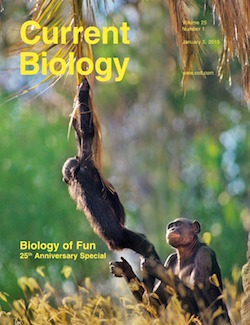 The journal Current Biology, in celebrating its 25th birthday (congratulations!), published a special issue that includes two articles touching on the Ig Nobel Prizes.
The journal Current Biology, in celebrating its 25th birthday (congratulations!), published a special issue that includes two articles touching on the Ig Nobel Prizes.
Geoffrey North, the journal’s editor, wrote an editorial called “The Biology of Fun and the Fun of Biology“:
Both [the artist] Magritte and [the artistic chef] el Bulli illustrate one aspect of ‘fun’ that is relevant to Current Biology — and that is the element of surprise…. One thing Current Biology is known for is being rather unpredictable; people often tell us we are a bit ‘quirky’, and they generally mean this as a compliment. This likely relates to the ‘pleasure of novelty’: it is a common experience that when something, even a great work of art, is experienced too often within a short period of time, the pleasure evoked strongly diminishes.
The idea of ‘fun’ in work does not necessarily imply frivolity, or triviality — fun can be had in work that results in a Nobel Prize (theoretical physicists, such as Richard Feynman, seem particularly prone to this), as well as that rewarded with an Ig Nobel Prize. And interestingly, the latter has evolved into a worthy prize: a paper we published in 2013 [Current Biology, 2013, R298–R300.] was awarded an Ig Nobel Prize, and as one of the authors of that paper, Marie Dacke, explained in her Q & A last year [Current Biology, 2014, R546–R547.], the prize is now awarded for “research that first makes people laugh and then makes them think”, which has to be a wholly good thing.
Michael Gross wrote an essay called “The joy of science communication“:
Ridicule is always a question of perspective…. This perspective-dependent combination of seriousness and oddity is what keeps the Ig Nobel Prizes in business. These prizes are celebrated just before the less entertaining Nobel Prizes and have been going strong since 1991, just like Current Biology. The 2014 honour roll includes, for instance, work about the behavioural reaction of Svalbard reindeer to humans dressed up as polar bears (or not – you always have to include a control experiment), the mental health hazards of keeping cats, pain sensitivity of people looking at good or bad paintings, and dogs aligning with the Earth’s magnetic field when defecating (http://www.improbable.com/ig/ig-pastwinners.html).
Surely, each of these research projects was based on a reasonable question and may even have yielded valuable results. The scientists in question may not have appreciated at the beginning that a one-line description of their activity might look faintly ridiculous, especially if reported by media around the world. Still, recipients of the Ig Nobels typically attend the ceremony in good spirit and may ultimately benefit from the extra publicity for their work which might have otherwise fallen into oblivion quite fast….
Ig Nobility: The annual Ig Nobel Prizes aim to “first make people laugh, then make them think.” In 2014, the art prize was awarded to Marina de Tommaso, Michele Sardaro and Paolo Livrea of Italy, for measuring the relative pain people suffer while looking at an ugly painting, rather than a pretty painting, while being shot in the hand by a powerful laser beam. The photo shows Nobel laureate Frank Wilczek, who helped hand out the Ig Nobel Prizes to the new winners at the 2014 Ig Nobel Prize ceremony at Harvard, being exposed to an ugly painting. (Photo: Alexey Eliseev/Improbable Research.) [to see an enlargement, click on the image]
This year will, indeed, also see the 25th birthday of the Ig Nobel Prize ceremony. The 25th First Annual Ig Nobel Prize Ceremony will happen on Thursday, September 17, 2015. You are invited to attend the festivities at Harvard University (should you manage to obtain a ticket) or to watch the live webcast.
Short essays – are they long?
When it comes to student essays, is a very short essay short because it’s short, or is it short because it’s shorter than a long one? Dr Simon Bell, Ph.D., M.A., Pg.Dip., Pg.Cert., B.A (Hons), who is Course Director and Senior Lecturer in Graphic Design at the School of Art and Design, Coventry University, UK, asks just this question in the Proceedings of the 6th International Conference of Education, Research and Innovation Seville, Spain,18-20 November, 2013. (ICERI2013 Proceedings, pp. 961-968)

Note: Dr. Bell required his students to produce 128-word essays which were bounded by a square, possibly similar to the one above.
Bonus: A famous quote – variously attributed either to Mark Twain or Blaise Pascal or possibly Cicero :
“I apologize for writing you a long letter. I didn’t have time to write you a short one.”
January 11, 2015
Medicine is sprinkled with metaphorical crumbs
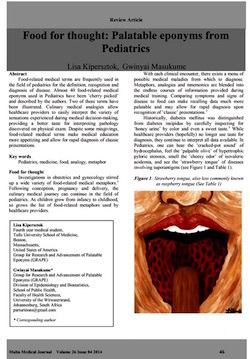 My colleague Lisa Kipersztok (a final-year medical student at Tufts University) and I (Gwinyai Masukume, at the University of the Witwatersrand) have collected and arranged a new feast of medical food metaphors.
My colleague Lisa Kipersztok (a final-year medical student at Tufts University) and I (Gwinyai Masukume, at the University of the Witwatersrand) have collected and arranged a new feast of medical food metaphors.
We follow in the footsteps of hungry giants. In the late 1970s Terry and Hanchard in their seminal paper, titled “Gastrology: the use of culinary terms in medicine” [PDF], appearing in the British Medical Journal, offered the real first course of food-related medical terms in medical literature.
Almost 50 years later this all consuming field of medicine continues to bear fruitful papers. Lisa and I developed a taste for these medical food-derived terms as used in Pediatrics.
Bridging art and science, we share culinary medical terms, include hand-painted illustrations and offer food for thought on how these terms help and also challenge healthcare workers today. Here is our paper, “Food for thought: Palatable eponyms from Pediatrics,” [PDF], in the December 2014 issue of the Malta Medical Journal.
For the food (and medical) connoisseurs, here is a we prepared, providing a feast for the senses.
And for those who might be wondering how some people see food in unusual places please see the illustrative image (egg-on-string-sign found in a particular heart abnormality) – seeing food is an inexact science!
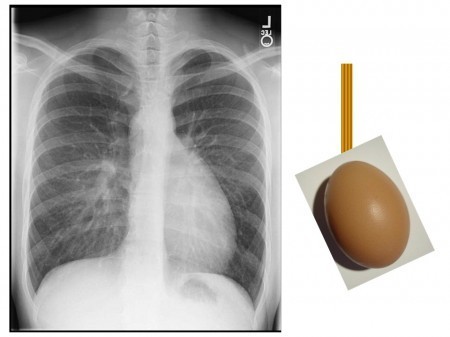
Egg-on-string sign, images from: https://en.wikipedia.org/wiki/File:Tr... https://commons.wikimedia.org/wiki/Fi...
BONUS: Previously on this blog another slice from this delectable field.
January 10, 2015
Cleese opines to great effect on Dunning and on Kruger
John Cleese, the tallest and angriest of the Monty Pythons, tells here, in this video, of his controlled, venomous glee at learning about the Dunning-Kruger Effect:
The Open Culture blog comments about Cleese’s commenting.
David Dunning and Justin Kruger — the Dunning and the Kruger of the Dunning-Kruger effect — were awarded the 2000 Ig Nobel Prize for psychology, for their study “Unskilled and Unaware of It: How Difficulties in Recognizing One’s Own Incompetence Lead to Inflated Self-Assessments.” The study was published in the Journal of Personality and Social Psychology, vol. 77, no. 6, December 1999, pp. 1121-34.
BONUS: Ig Nobel winner David Dunning surveys recent research about incompetent people
January 9, 2015
Country Music singers’ chins and general hard times
Professor Terry Frank Pettijohn II, of Coastal Carolina University, is the lead author of a new study which investigates the ‘Chin Area’ (and other facial features such as ‘Eye Width’) of US country Music singers between 1946 and 2010 – and examines possible correlations with an index of economic and social conditions called the General Hard Times Measure (GHTM).
“When conditions were relatively poor, country music artists with more mature facial features of smaller eyes and larger chins were popular, and when conditions were more prosperous, country music artists with more baby-faced features of larger eyes and smaller chins were popular.”
See: ‘Facial Feature Assessment of Popular U.S. Country Music Singers Across Social and Economic Conditions’ by: Terry F. Pettijohn II, Jamie N. Glass, Carly A. Bordino, and Jason T. Eastman, in: Current Psychology, December 2014, Volume 33, Issue 4, pp 451-459
Note: The paper costs $39.95 (for non-subscribers) to read, but a handout by the same authors (a poster presented at the 25th Annual Association for Psychological Science Convention) is available here, free of charge.
Also see: More from Professor Terry Frank Pettijohn II ‘Hungry people prefer maturer mates?’
Marc Abrahams's Blog
- Marc Abrahams's profile
- 14 followers



